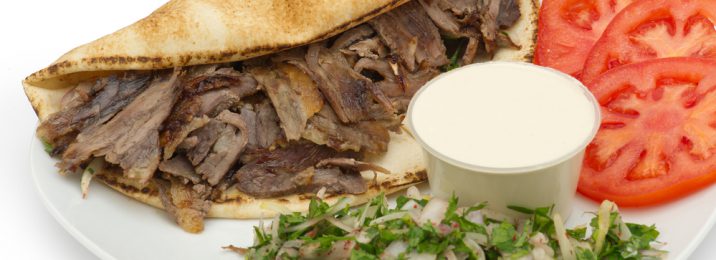
02/08
The Origin of the Shawarma
The shawarma evokes a visual imagery of slow-grilled meat on a warm bread, a comfort food picked up in a corner deli on a lunch break. While the shawarma has been unjustly categorized by some as a fast food item, it is more than the exotic cousin of the sandwich. It is tradition wrapped in a delicious treat.
While the true origin of the shawarma remains unclear, the tasty dish has been described as part of traditional Levantine cuisine, which is popular in a region encompassing areas in the Middle East and the Mediterranean. Regional variations of the shawarma exist but the basic elements are there. In fact, culinary iterations or similar versions of the shawarma can be found not only in the Middle East and the Mediterranean, but in regions such as Northern Africa. In Greece, they have the gyro. And in Turkey, they have the doner kebab. Both dishes involve a similar spit grilling process.
The dish may have gained popularity throughout the region through the influence and spread of the Turkish-Ottoman empire. In fact, the word shawarma was said to have originated from the Turkish word “çevirme”, which describes the turning process of cooking the meat. This method of grilling, which is still used today, involves placing the cone-shaped slab of meat on a horizontal or vertical spit to be cooked for hours over hot coals or firewood. The axial rotation ensures that the meat is equally cooked on all sides.
Based from the shawarma’s popularity, it could be said that it has transcended food fad and trends, and probably entered mainstream food territory. While the modern shawarma is now grilled using commercial gas or electric-fired rotisserie, the basics are still there. One can choose over grilled lamb, goat, chicken, or beef, shaved from the grilled slab of meat, and placed with vegetables such as tomatoes and cucumbers. Options for sauce paired with the mix also varies It could be a garlic toumaia, hummus or a sesame-based tahini sauce. Depending on the location, regional preference, and tradition, the delicious combo could be wrapped in some type of flat bread. It could be laffa or taboon bread, or lavash.
But despite being part of the mainstream culinary consciousness and taste for quite some time, the word “shawarma” was only recently recognized in the Merriam-Webster’s Collegiate Dictionary. In fact, it was only nearly 8 years ago when the word was included in the list, along with 99 other words. But of course, this omission hardly matters to those who have been appreciating the taste of shawarma for years.




